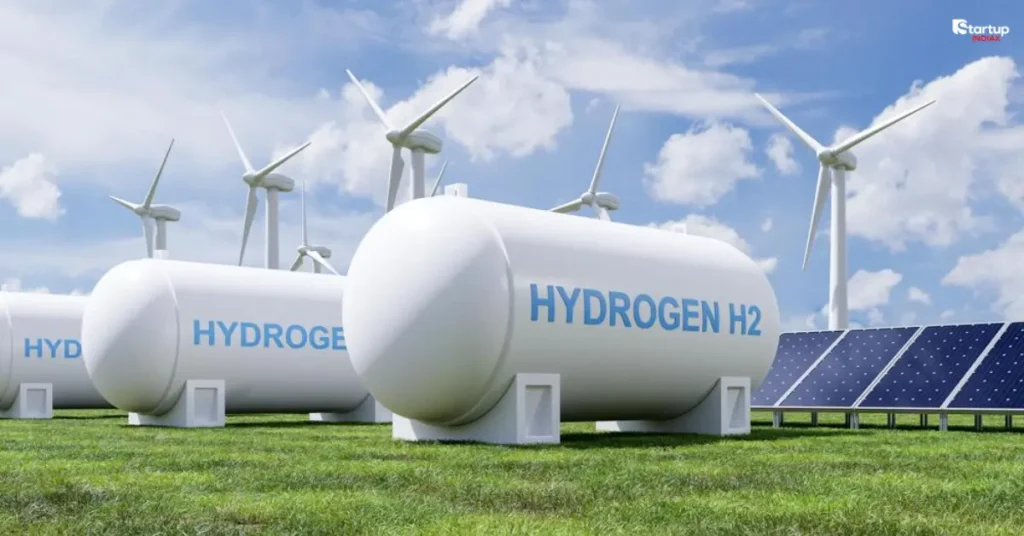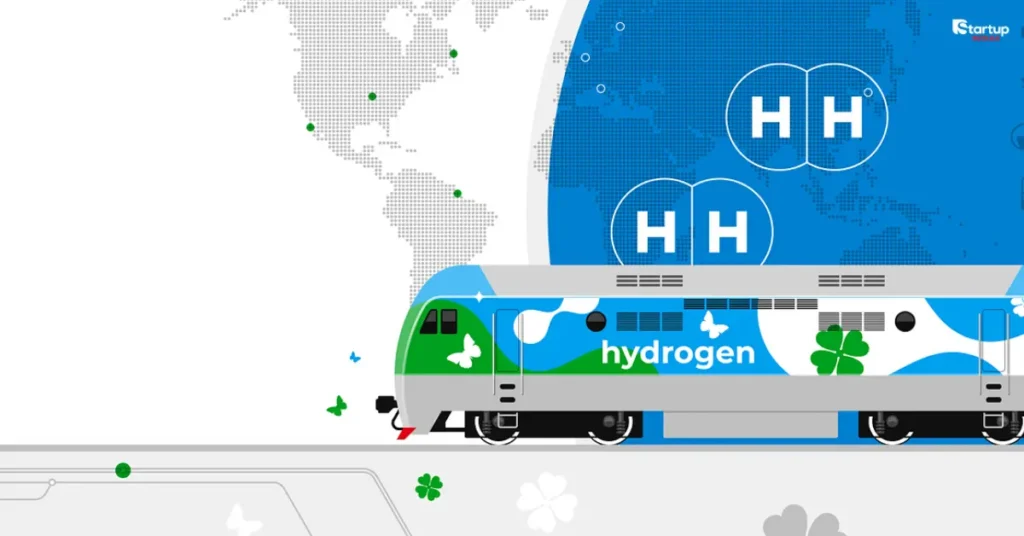Summary
- What Is Green Hydrogen? Green hydrogen is a clean fuel produced using renewable energy, powering India’s ambitious plan to roll out 35 eco-friendly trains, each costing Rs 80 crore, as part of the “Hydrogen for Heritage” initiative.
- Why It Matters: This Startup INDIAX feature explores how India’s hydrogen trains, with their 1,200 HP engines, reduce emissions and reliance on fossil fuels, positioning India as a global leader in sustainable rail transport.
- Learn and Engage: Discover the technology, costs, and challenges behind India’s green hydrogen revolution, and join the conversation on Startup INDIAX to shape a sustainable future.
Table of Contents
What Is Green Hydrogen and Why Is It Revolutionary?
Green hydrogen is transforming the global energy landscape, and India is at the forefront of this revolution. Unlike grey or blue hydrogen, which rely on fossil fuels, green hydrogen is produced through electrolysis powered by renewable sources like solar or wind. This process splits water into hydrogen and oxygen, emitting zero carbon. According to the International Energy Agency, green hydrogen could meet 24% of global energy demand by 2050, slashing emissions significantly.

For entrepreneurs and startups, green hydrogen represents a massive opportunity. As Dr. Ajay Mathur, Director General of the International Solar Alliance, states, “Green hydrogen is the fuel of the future, enabling decarbonization across industries.” Its versatility makes it ideal for transportation, manufacturing, and energy storage, aligning with India’s net-zero goals by 2070.
How Does Green Hydrogen Work?
Green hydrogen is created by passing electricity from renewable sources through water in an electrolyser, producing hydrogen gas. This gas is stored and used in fuel cells, where it reacts with oxygen to generate electricity, with water vapor as the only byproduct. In trains, this electricity powers electric motors, eliminating the need for diesel or overhead wires. The process is clean, efficient, and scalable, making it a game-changer for sustainable transport.
Why Is Green Hydrogen Eco-Friendly?
Green hydrogen trains, or “hydrail,” produce zero carbon emissions and are 60% quieter than diesel engines, per Indian Railways data. They reduce air pollution and greenhouse gases, supporting India’s National Green Hydrogen Mission, which aims for 5 million metric tonnes of annual production by 2030. For startups, this opens doors to innovate in hydrogen production, storage, and refueling infrastructure.
How Is India Pioneering Green Hydrogen in Railways?
Indian Railways, one of the world’s largest rail networks, is betting big on green hydrogen. The successful trial of a 1,200 HP hydrogen-powered coach in Chennai marks a milestone in India’s journey toward sustainable transport. Startup INDIAX recognizes this as a bold step toward decarbonizing a network that spans 68,584 kilometers and serves millions daily.
What Is the “Hydrogen for Heritage” Initiative?
Launched in 2023, the “Hydrogen for Heritage” project aims to deploy 35 hydrogen fuel cell trains on heritage and hilly routes like Kalka-Shimla and Darjeeling Himalayan Railway. With a budget of Rs 2,800 crore, the initiative retrofits existing Diesel Electric Multiple Unit (DEMU) rakes with hydrogen fuel cells. Each train, capable of carrying 2,638 passengers at 110 km/h, is a testament to India’s indigenous technology, developed by the Research Design and Standards Organisation (RDSO).

How Much Will Each Hydrogen Train Cost?
Each hydrogen train costs approximately Rs 80 crore, with an additional Rs 70 crore per route for infrastructure like hydrogen production and refueling stations. For instance, the Jind-Sonipat route in Haryana, covering 356 kilometers, features a 1-megawatt Polymer Electrolyte Membrane (PEM) electrolyser producing 430 kg of hydrogen daily. While the initial investment is steep, experts predict costs will drop as production scales, making green hydrogen competitive with diesel.
What Makes India’s Hydrogen Trains Unique?
India’s hydrogen trains stand out globally due to their power and innovation. Unlike Germany’s Coradia iLint trains, which operate at 500–600 HP, India’s engines deliver a staggering 1,200 horsepower, making them the most powerful hydrogen trains worldwide. This achievement, driven by RDSO and Integral Coach Factory (ICF) in Chennai, showcases India’s technological prowess.
How Powerful Are India’s Hydrogen Engines?
The 1,200 HP engines, developed indigenously, enable trains to navigate diverse terrains efficiently. Medha Servo Drives, a Hyderabad-based startup, handles technical integration, ensuring components like traction motors and battery systems meet global standards. German safety auditor TÜV SÜD has been roped in to validate safety, reinforcing trust in the technology. As Railway Minister Ashwini Vaishnaw noted, “India’s hydrogen train technology will lead globally, with applications beyond railways.”
What Routes Will These Trains Cover?
The inaugural route, Jind-Sonipat, is a 90-kilometer stretch chosen for its moderate traffic and proximity to refueling infrastructure. Future routes include heritage circuits like the Nilgiri Mountain Railway and non-electrified sections where diesel trains dominate. These routes align with India’s vision of sustainable tourism, blending cultural heritage with green innovation.
What Are the Challenges and Future of Green Hydrogen in India?
While green hydrogen is promising, scaling it poses challenges. High production costs and infrastructure needs are hurdles, but India’s ambitious plans signal a bright future. The National Green Hydrogen Mission, with an outlay of Rs 19,744 crore, supports pilot projects, R&D, and electrolyser manufacturing to drive down costs.
Why Is Scaling Green Hydrogen Costly?
Currently, green hydrogen costs around Rs 492/kg in India, 27% more than diesel, per ICRA research. Building refueling stations, like the one in Jind with 3,000 kg storage capacity, requires significant investment. However, as renewable energy prices drop and production scales, costs are expected to decline, making hydrogen trains economically viable.
How Will India Overcome These Challenges?
India is leveraging partnerships with startups and global players. GreenH Electrolysis, a joint venture with H2B2 Technologies, is building refueling infrastructure in Jind. The government’s Strategic Interventions for Green Hydrogen Transition (SIGHT) program incentivizes domestic electrolyser production. For entrepreneurs, this creates opportunities to innovate in hydrogen storage, fuel cells, and renewable energy integration.
Conclusion: Why Green Hydrogen Matters for India’s Future
India’s push for green hydrogen trains is more than a technological leap; it’s a commitment to sustainability, energy independence, and innovation. By launching 35 hydrogen-powered engines, Indian Railways is setting a global benchmark for eco-friendly transport. Entrepreneurs and startups can seize this moment to build solutions in the green hydrogen ecosystem, from production to application.
Join the conversation on Startup INDIAX! Share your thoughts on green hydrogen’s potential or explore more stories on India’s startup and tech innovations. Comment below or connect with us to shape a sustainable future.
FAQs
What is green hydrogen?
Green hydrogen is produced via electrolysis using renewable energy, creating a clean fuel with zero carbon emissions, ideal for sustainable transport like India’s hydrogen trains.
How do hydrogen trains work?
Hydrogen trains use fuel cells to combine hydrogen and oxygen, generating electricity to power motors, with water vapor as the only byproduct.
Why is India investing in hydrogen trains?
India aims to reduce carbon emissions, eliminate diesel use, and achieve net-zero by 2070, with hydrogen trains offering a clean alternative for non-electrified routes.
How much do India’s hydrogen trains cost?
Each train costs Rs 80 crore, with Rs 70 crore per route for infrastructure like refueling stations, totaling Rs 2,800 crore for 35 trains.
When will India’s hydrogen trains be operational?
Trials began in 2025 on the Jind-Sonipat route, with full deployment of 35 trains expected by 2026.

